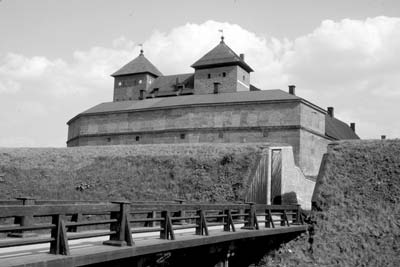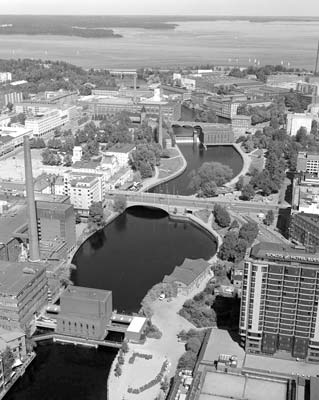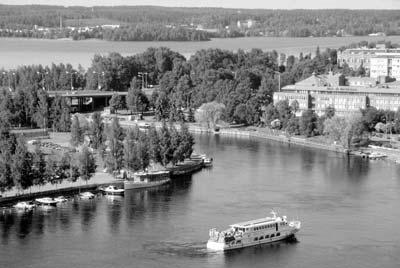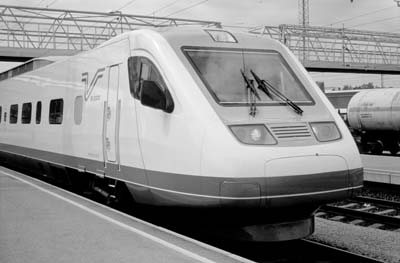Pendolino to Tampere
by Jay Brunhouse
While you feel the acceleration of your S220 Pendolino to Tampere leaving Hämeenlinna, Finland, look left for one of the most impressive sights you can see from a mainline train. The view across the narrow lake reveals the redbrick Hämeenlinna (linna meaning “castle”), dating from the 1260s. It was built by the Swedes to link the Häme region with the mother country and — you guessed it — to collect taxes from the relatively wealthy area.
Hämeenlinna was the northern terminus of Finland’s first railroad line from Helsinki in 1862, and it was used for transloading goods between railroad and lake steamer. Rapid progress soon extended the line to Tampere and via Helsinki to St. Petersburg.
Hämeenlinna’s present station building was erected in 1920 following the former station’s demolition during the Finnish revolution when Germans, who were supporting “White” Finns in their battles with the “Red” Finns, exploded a railroad carriage filled with gunpowder.
Lakes, parks and rolling hills
When you first arrive in Tampere, one glance at the tall, brick smokestacks makes you feel that Tampere is industrialized, but in fact this is misleading. Heavy industry abandoned Tampere, and now Nokia, the leading cellular telephone manufacturer, has 3,600 R&D engineers in Tampere designing astonishing new devices.
Tampere (www.tampere.fi), population 200,000, is a lively city of lakes, parks and rolling hills located primarily on a narrow strip of land between two lakes. With blissful Lake Näsijärvi lapping at the center’s edge, you walk wide boulevards past quiet green parks, see the plentiful hotels, Art Nouveau architecture from which Finland adopted its national Romantic style, and rolling hills that are the highest mountains in glacier-ravaged Finland. Tampere has a welcoming, relaxed, small-town feel and everything is within walking distance of the train station.
Natural beauty is an essential feature of Tampere. The lakes and rapids and high ridges comprise key elements of the scenery. Pispala Ridge is a charming district of old housing, narrow lanes and steep hills with views overlooking both lakes with views all the way to the city of Nokia.
Tampere residents use the refreshing lakes for cruising, rowing, fishing, camping, swimming and water skiing. In winter, residents ice fish and skate and of course enjoy the national recreation, the Finnish sauna.
Present-day Tampere is built on an industrial heritage. A walk along the banks of the Tammerkoski Rapids shows, building by building, how the city grew to be a powerhouse of the Finnish textile, engineering and wood processing industries. Today the redbrick factories still ring with the work of cotton-mill girls, ironworkers and pump mill laborers but are home to new enterprises and are chock-full of museums, restaurants, cafés, culture and entertainment.
Those now-quiet stacks rise above brick industrial buildings that once housed an iron mill dating from 1843, factories manufacturing grinders and water turbines, ships and locomotives and, later, arms and ammunition. In its heyday, the Finlayson cotton mill was a city within a city. Factory halls echoed with the steady pounding of machinery while Finlayson, a Scot, lived in his palace cultivating pineapple and socializing with the Russian emperor.
High-speed S220 Pendolino
Your Finnish Railroads’ (VR) tilting S220 Pendolino trains cut travel time by 21 minutes on the fully electrified Ostrobothnian line between Tampere and Helsinki. They are so named because they speed up to 220 km/hr (137 mph) on conventional track.
After VR took possession of their first S220 Pendolino electric tilting trains in 1996, the trains were so successful in chopping travel time — with a 95% on-time record — that VR put a second series of eight more Pendolino trains into service in 2001, overhauled the original sets, extended their range and introduced new Helsinki-Tampere-Oulu and Turku-Tampere services. Compared with the first sets, the latest units have sanding gear, low-noise wheels and better snow protection for the tilt mechanisms.
The S220, which is a Fiat adaptation of Italy’s ETR460 Pendolino, is unique as the world’s first wide-gauge and most spacious tilting train. You have plenty of room in the airy carriages because the lines were laid before Finland became independent of Russia and use nearly the same wide gauge (about five feet) as in Russia. Finnish Pendolinos are wider by almost 16 inches, and higher by 10.6 inches, than their counterparts running in Italy.
While Italy’s Pendolino has a dining car suitable for long-distance travel, the short travel time between Helsinki and Tampere allowed VR to substitute the self-service “Prego” restaurant with 22 seats, four standing tables and several menu choices.
The Helsinki connection
Every weekday, passengers ride the S220 Pendolino round trip between Tampere and Helsinki five times, and three run on Saturdays and Sundays as well. Three continue to Oulu and two continue to Jyväskylä. They are timed primarily to suit business travelers who want to reach Helsinki in the morning and depart in the afternoon.
S220 Pendolino trains alternate service between Helsinki and Tampere, with InterCity trains comprising single- and double-deck carriages dubbed IC and IC2. The four to six double-deck, air-conditioned, totally nonsmoking IC2 carriages made their debut in 2000. You can use the mini-buffet no matter on which deck you sit. There is a special play area for young children as well as compartments for families, the handicapped and travelers with allergies. You can take your pet along, and there are spaces for three bicycles.
VR offers two classes of travel that they call “business” and “second.” Second-class passengers sit 2+2 in seats equipped with radio panels. You also find plug contacts for laptops and cellular telephones. The carriages have phone amplifiers.
In business class, arranged 2+1, your ticket (or pass) includes the morning and afternoon newspapers, radio earphones, and coffee or tea with pastry from the self-service counter. In addition to the papers and earphones, hostesses serve breakfast or a snack to “business plus” class passengers who have paid in advance for a meal and sit in the “business plus” compartment.
Travelers over 65 receive a 50% discount on point-to-point tickets. VR honors Eurail products as well as Scanrail and Finnrail passes, but Scanrail holders must pay a supplement to ride Pendolino and IC trains. Holders of second-class railpasses may board second-class carriages, while holders of first-class passes enjoy the comforts of business class. Seat reservations are required.
I thank the Finnish Tourist Board (www.visitfinland.com) for arranging my trip and VR (www.vr.fi) for supplying the ticket. Finnair (www. finnair.com) provided my New York-Helsinki transportation, flying out of American Airlines’ sparkling new JFK terminal.




